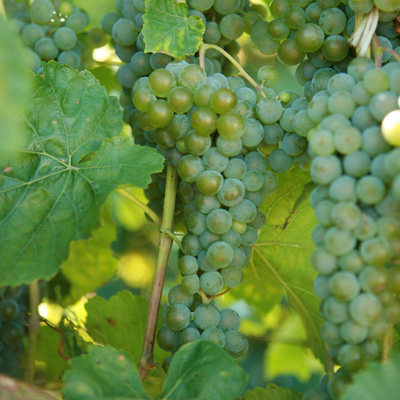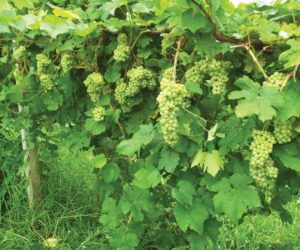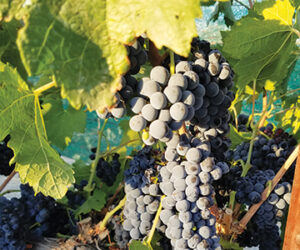Many years ago, during my school days at UC-Davis I primarily focused on coursework in enology. At the time, the degree programs focused on viticulture or enology, with a few crossover courses for either major. I affectionately referred to these crossover courses as “enology for dummies” for the viticulture folks, and “viticulture for dummies” for people like me. Never mind that my degree was in Food Science, but I was smart enough to understand that viticulture is tough! How tough is it? There are pests, both vertebrate and invertebrate, fungal susceptibility, and now there are the overall climate effects around the world. We were in Burgundy one recent summer and a hail storm came through, completely stripping the vines of leaves and developing fruit. Being a California winemaker, we worry about spring frosts, just like the rest of the country, however, I learned a new one when visiting the wine regions at last year’s Winemaker Conference in Traverse City, Michigan . . . the polar vortex!

Not only do cold-climate grape growers have to worry about the problems associated with the growing season, but the dormant season can also prove to be vicious. I am a firm advocate of planting the right variety on the right site. Vitis vinifera, the European wine grape, can be grown in colder climates and Europe can be cold in the winter, but the climate is attemperated by the warm Gulf Stream current coming across the Atlantic Ocean. But intense cold will certainly kill the vinifera species. In this situation, in climates that endure sustained cold snaps, it is better to choose wisely and plant a cold-hardy variety. LaCrosse, La Crosse, & Lacrosse: One may be a sport, another a city in northwest Wisconsin, but all three are ways this grape varietal is spelled.
Elmer Swenson (1913-2004) was the breeder responsible for LaCrosse. He began breeding grapes in 1943. For some time, Mr. Swenson worked in the horticulture department at the University of Minnesota; a university famed for its grape breeding programs specializing in cold tolerance. But he was actually a private breeder, working on his farm near Osceola, Wisconsin. He was responsible for countless varieties. I have been involved in grape breeding programs from the winemaking side, but the real troops in this endeavor are the folks gathering all the details in the vineyard. For an overview of the extensive details involved in Elmer Swenson’s grape breeding program, see this website: http://www.winemanager.com/slarsen/Grapebreeders/ES_parent.htm. The website lists all of his selections that were involved in his program . . . but this was actually just the tip of the iceberg. There were countless other seeds that were germinated and deemed not the right candidate for what he wanted. Many of his selections were patented and countless others given away on request, but he did co-release, with the University of Minnesota, three varieties: Edelweiss, Minnesota 78, and Swenson Red. Originally produced in 1970, LaCrosse was released to the public in 1983.
As was aforementioned, any grape breeder that has been around for a while has an immense library of vines to work with. LaCrosse’s parents are Elmer Swenson 114 and Seyval Blanc. We all know Seyval Blanc, but Elmer Swenson 114 (or ES 114 in shorthand) is one of those intermediary hybrids showing promise but not having all of the characters desired. When looking at the breeding data, ES 114 and its sibling ES 113 were the progeny of Minnesota 78 x Rosette. These were just two of the many seedlings that he carried through his program. So what happened to all the other seeds produced? For the purposes of this article, they are “buried” in the data. That data, for those that wish to delve into the details will show that the LaCrosse pedigree includes Vitis riparia, V. labrusca, V. vinifera, V. lincecumii, and V. rupestris. Incidentally, St. Pepin is LaCrosse’s sibling. Another seed from that ES 114 x Seyval Blanc that made it to the big leagues! Before Mr. Swenson named LaCrosse it was simply ES 294.
LaCrosse made the cut in that it will fare better than most wine grape varietals when that polar vortex sweeps down from the icy north. It is reported to be cold tolerant to -15 to -20 °F (-26 to -29 °C) making it an excellent candidate for growing in the Upper Midwest and cold, high-elevation locales: Iowa, Nebraska, Minnesota, Illinois, Pennsylvania, Utah, and Nevada to name some. However, not every year is a perfect year, and bud mortality can come up even amongst the hardiest of grape types. That was proven in 2014, 2015, and 2019. A study from Michigan State University concluded that “Michigan vineyards and others in Midwest states have demonstrated that vineyard productivity and sustainability is directly related to matching the cultivar with the site.” This not only includes choice of variety, but specific site practices such as pruning to specific bud numbers based on the season.
. . . in climates that endure sustained cold snaps, it is better to choose wisely and plant a cold-hardy variety.
The clusters of LaCrosse are small- to medium-sized with a more cylindrical shape to them. The berry skins are thin, which make it susceptible to black rot and Botrytis bunch rot, and its color ranges from yellow to green. It is slightly susceptible to downy mildew and moderately susceptible to powdery mildew. As with most grapes, maintaining a regular spray program is recommended. It’s a vigorous vine with a mid-season bud break and a later ripening of the grapes compared to some.
Of course in these extreme climate zones, not only should the grape be cold tolerant, but also needs to taste good, and produce balanced wines. That was my role in the Pierce’s Disease resistance breeding program at UC-Davis before I retired. I was given a small amount of fruit with the mission of making the best possible wine. Over the ten years, making at least 30 different wines per season, the program finally released five new varieties. My role was only ten years of the program, but the breeding had been going on for at least a decade before then. Elmer Swenson worked his magic for decades with the cold-hardy varietals.
For LaCrosse, the wine styles range from simple dry to semi-dry stainless steel or barrel-fermented wines, to the extreme of the ice wine style. Incidentally, and with a tongue in the cheek, if you want to make ice wine, make sure you harvest before the polar vortex comes in ☺. Seriously, LaCrosse is delightful as a varietal and it also holds credibility in blending with other wines. Contributing pear and apricot flavors to citrus and floral depending on the ripeness and fermentation conditions. Sugars at harvest are lower, often around 19–21 ºBrix, resulting in lower alcohols and higher acidities. Of course, these are the numbers we hope for when the fruit arrives. But every growing season has its challenges for every variety, and sometimes LaCrosse proves to be more prone to blending than single varietal.
Ensuring success with LaCrosse begins when the fruit is received into the winery. Processing the juice gently to prevent the potential over extraction of bitter seed and skin tannins is a start. Cold settling the gross lees and racking are close second. Yeast choice comes next. Lalvin QA23 has long been my favorite for white wines. (Although, as an aside, I think this strain needs more nitrogen than is reported — just something to keep in mind.) That said, any yeast that can convert flavorless thiol precursors into aromatic compounds and produce higher level polysaccharides is something to consider. CY3079 comes to mind if you want to leave a little sweetness. Barrel fermentations help enhance mouthfeel and flavors as well. In small batches, home winemakers can utilize oak chips in the fermentation. Evaluating the total acidity post fermentation will determine if a malolactic fermentation is needed. This is where tasting across all your wines is important to see if LaCrosse is the lone hero or the team player. For most white wines, I advocate getting it to the bottle in the spring for a pre-summer release, and wishing you had more at Labor Day.
It’s all in a name, so I am told. Things don’t have to get confusing in how it is spelled. I encounter this conundrum with just about every variety I write about. When you work with the grape breeders, and they have so many “no-name” varieties, coming up with a name that will be well received is an additional challenge to the problem. But then again, how is it spelled? My most confusing example is Riesling; is it ‘i’ before ‘e’ or vice versa (like Old MacDonald’s e-i-e-i-o) or in this case La Crosse, Lacrosse, or LaCrosse. While it appears that all would be acceptable, the Code of Federal Regulations lists LaCrosse as the accepted spelling.
You decide.
LaCrosse recipe Yield 5 gallons (19 L)
Ingredients
125 lbs. (57 kg) LaCrosse grapes or 6 gallons (23 L) of commercially available juice — clarified. If you are using juice, skip to step 4.
Distilled water
10% potassium metabisulfite (KMBS) solution (Weigh 10 grams of KMBS, dissolve into about 75 mL of distilled water. When completely dissolved, make up to 100 mL total with distilled water.)
5 g Lalvin QA23 yeast (Lalvin CY3079 can be used as a substitute)
5 g Fermaid K (or equivalent yeast nutrient)
5 g Diammonium phosphate (DAP)
Other equipment or needs specific to this recipe
5-gallon (19-L) carboy
6-gallon (23-L) carboy
6-gallon (23-L) plastic bucket
(1–2) one-gallon (3.8-L) jugs
Airlock/stopper
Racking hoses
Equipment cleaning and sanitizing agents (Bio-Clean, Bio-San)
Inert gas (nitrogen, argon, or carbon dioxide)
Refrigerator (~45 °F/7 °C) to cold settle the juice. (Remove the shelves so that the bucket will fit.)
Ability to maintain a fermentation temperature of 55 °F (13 °C) TIP: Use a 33-gallon (125-L) plastic can as a water bath. Place ice blocks in the water to maintain a relatively constant temperature. This will be your refrigeration system for peak fermentation. If you have other means to keep things cool, of course use that.
Thermometer capable of measuring between 40–110 °F (4–43 °C) in one degree increments
Pipettes with the ability to add in increments of 1 milliliter
Ability to test or have testing performed for sulfur dioxide
Step by step
- Crush and press the grapes. Do not delay between crushing and pressing. Move the must directly to the press and press lightly to avoid extended contact with the skins and seeds.
- Transfer the juice to a 6-gallon (23-L) bucket. During the transfer, add 16 milliliters of 10% KMBS solution (This addition is the equivalent of 40 mg/L (ppm) SO2). Move the juice to the refrigerator. Transfer any extra juice into one-gallon (3.8-L) jugs and settle as with the main lot of juice.
- Let the juice settle at least overnight. Layer the headspace with inert gas and keep covered.
- Measure the Brix and record results.
- When sufficiently settled, rack the juice off of the solids into the 6-gallon (23-L) carboy.
- To the juice in jugs: Rack off the solids, return to the jugs and freeze.
- Prepare yeast. Heat about 50 mL distilled water to 108 °F (42 °C). Measure the temperature. Pitch the yeast when the suspension is 104 °F (40 °C). Sprinkle the yeast on the surface and gently mix so that no clumps exist. Let sit for 15 minutes undisturbed. Measure the temperature of the yeast suspension. Measure the temperature of the juice. You do not want to add the yeast to your cool juice if the temperature of the yeast and the must temperature difference exceeds 15°F (8 °C). To avoid temperature shock, acclimate your yeast by taking about 10 mL of the juice and adding it to the yeast suspension. Wait 15 minutes and measure the temperature again. Do this until you are within the specified temperature range, then pitch. Do not let the yeast sit in the original water suspension for more than 20 minutes.
- Add Fermaid K or equivalent yeast nutrient.
- Initiate the fermentation at room temperature ~(65–68 °F/18–20 °C) and once fermentation is noticed, (~24 hours) move to a location where the temperature can be maintained at 55 °F (13 °C).
- Two days after fermentation starts, dissolve the DAP in as little distilled water required to completely go into solution (usually ~20 mL). Add directly to the carboy.
- Normally you would monitor the progress of the fermentation by measuring Brix. One of the biggest problems with making white wine at home is maintaining a clean fermentation. Entering the carboy to measure the sugar is a prime way to infect the fermentation with undesirable microbes. So at this point, the presence of noticeable fermentation is good enough. If your airlock becomes dirty by foaming over, remove, clean it, and replace as quickly and cleanly as possible. Sanitize anything that will come in contact with the juice.
- Leave alone until bubbles in the airlock are about one bubble per minute. Usually about two to three weeks, then measure the Brix every 2–3 days.
- The wine is considered dry, or nearly dry, when the Brix reaches -1.5 °Brix or less. Taste for quality. If the wine is too tart, consider inoculating for malolactic fermentation (MLF). If you choose MLF, carry to completion and then add 3 mL of fresh KMBS (10%) solution per gallon (3.8 L) of wine. This is the equivalent to ~40 ppm addition. Transfer the wine to the 5-gallon (19-L) carboy and lower the temperature to 38–40 °F (3–4 °C).
- An alternative to that is backsweetening with the previously frozen juice to taste. If you choose to sweeten, perform trials with the now thawed juice. After sweetening, what’s left, you might as well ferment. For what you sweetened, add 3 mL of fresh KMBS (10%) solution per gallon (3.8 L) of wine.
- After two weeks, test for pH and SO2. Adjust as necessary to attain 0.8 ppm molecular SO2. (There is a simple SO2 calculator at www.winemakermag.com/guide/sulfite). Check the SO2 in another two weeks, prior to the next racking and adjust while racking. Rack to another sanitized 5-gallon (19-L) carboy, or a bucket. In the case of the latter, clean the original carboy and transfer the wine back into it. This is done at about 4–6 weeks after the first SO2 addition. Once the free SO2 is adjusted, maintain at the target level by monitoring every 3–4 weeks.
- Consult winemakermag.com for tips on fining and filtration.
- At about three months you are ready to bottle. Be sure to maintain sanitary conditions while bottling. Once bottled, you’ll need to periodically check your work by opening a bottle to enjoy with friends.






